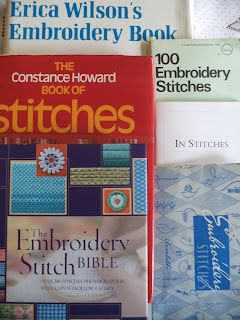Threads
In this module and course a thread is anything that can be threaded into a fabric surface, both traditional and non-traditional. This includes knitting yarns, machine threads, metallic threads, wire, string, ribbon, fabric strips, plastic strips, grasses, sea weed, shoe laces, and raffia. Non flexible includes solid items such as pins, twigs, and wooden sticks.
Where the appropriate needle cannot punch through fabrics, or the thread has qualities that resists easy sewing or the fabric restrains puncturing then the items can be held in place through couching or weaving, wrapping around stitches in a lower layer of stitching.
This chapter contains work mostly in white threads on black fabrics.
A collection was made of a selection of threads and put in an open tray:
Insert picture of tray of threads
It is useful to keep a dictionary of threads, with a note of its name, where obtained and cost for calculating expenditure on the final sample. A dictionary is in alphabetical order, this is not, but I have tried to arrange them by natural threads on the left and man made on the right, trying to group them by type e.g cotton, silk, wool or pipe cleaner, polyester, viscose.
Insert picture of card file
Since producing this file I have transferred the cards into a walleted photograph album, not so bulky and easier to look through. The sequence remains the same.
Stitches and stitching
The same stitch can often have different names, sometimes related to the location where it can be found.
It is interesting to try and learn those that give different variations in shape and formation. I have tried to extend my knowledge by learning new ones, with help from different publications.
Insert photo of some reference sources
I have a record of those stitches used in this chapter, by reference to books with pages in my notebook including some indication of additional information. 100 Embroidery stitches is grouped by categories, (shown below), Erica Wilson's book is arranged by sewing technique with those stitches of use in that technique, such as Crewel embroidery. Most books have black and white illustrations, whereas The Embroidery Stitch Bible is in colour. I particularly liked Jan Beaney and Jean Littlejohn's as well as Constance Howard's as illustrations were in monochrome and gave a vast range of both formal and informal approaches to stitching using a particular or variations on it.
Here are five categories of stitch based on how they are physically formed.
I have tried 4 or 5 from each type, the names given alongside the category in order as shown in the sample below:
- Flat stitches, formed with a simple straight stitch, such as Herringbone, Thorn, Dot or seed, Chevron and Cross
- Looped stitches, formed by looping the thread under the needle, such as Fly, Cretan, Feather, Blanket and Wave
- Chained stitches, formed by connecting loops, such as Chain, Chain cable, Wheat ear, Split, and Twisted chain
- Knotted stitches, formed like a loop but pulled firmer, such as French knot, Knot (Snail's Trail), Bullion, and Coral
- Composite stitches, formed in different ways combining two layers of stitch. An initial stitch with another stitch formation by needle threading, whipping or lacing, such as Laced running, Whipped chain, Laced Herring Bone and Interlaced Herring Bone
Once a basic stitch is learnt it is fascinating to see how it can be manipulated into different effects, by varying size, spacing, direction and using different threads or different numbers of strands of the same thread.
I chose Fly Stitch in order to make a series of Formal stitching rhythms and Informal stitching rhythms.
Formal stitching rhythms
Used 6-ply cotton embroidery threads with variation in the number of strands used
Insert photo of Sampler with formal stitching using frame to stretch and firm the fabric layer
This is a grid of 3 x 5 4cm squares
Going down in rows starting with the top row, from left to right
First row: Worked in a linear pattern - four rows altering the length of the tail; as the first, but stitches on their side; Separate marks
Second row: Varying the size of stitch - four rows, Alternately altering the direction of the stitches, first individual stitches then alternate rows
Third row: Using one strand Varying the direction, at an angle, elongating the stitch and spacing different groups
Fourth row: Increasing the number of threads for tonal change; Arranging the threads to form a circular design; Altering the angle in rows to form a new pattern
Fifth row: Altering the main stitch into a variation of it, in this example twisted fly stitch - frequency direction and size; Inserting stitches in rows within each other to form a shape; Mixture of stitches, varying size, direction and thicknesses with some overlapping
Down the side: a snake like arrangement - varying size, length of tail to smaller individual fly stitches
Informal stitching rhythms
For this produced an array of rhythmical patterns, varying stitch size, direction, arrangements, overlapping, creating new shapes, with different threads, weaving and adding beads. Great fun trying different ways of using fly stitch and twisted fly stitch. The sampler is the length of a ruler 30cms
Insert photo of Sampler with informal stitching
In further chapters as well as using Fly stitch will try to vary the stitches and threads to capture the texture of the work.
The following illustration is showing the back of pebbles held within fabric and is an addition to an earlier chapter.
It is not related to the chapter 9 content.









No comments:
Post a Comment